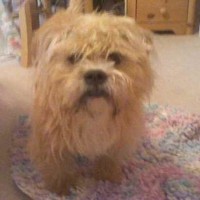Appearance of the English Lhasa Bull
|
| The two parent breeds that contribute to the English Lhasa Bull can be very different from each other in terms of structure and appearance, so there can be a great deal of variation in appearance from one dog to the next, even with dogs from the same litter. This hybrid generally has a broad, slightly rounded head with a fairly broad short to medium muzzle; those who prefer the Bulldog side of their heritage will have shorter, broader muzzles and heads than those who prefer the Lhassa Apso. Their dark brown eyes are generally round and set low, and they have ears that will be set high on the head and fold sideways as a pendant or backwards in a configuration known as a pink ear. Both dogs are robust, but the English Bulldog is considerably bulkier than the Lhassa Apso, and the hybrid can take its general form from either of the parent breeds. The biggest difference between the two is the coat, with the Lhassa Apso sporting a coarse coat of long, flowing fur that covers a thick, dense undercoat, and the English Bulldog sporting a single layer of short, smooth fur that lies close to the skin. The cross may inherit a coat or elements of both. |
Temperament of the English Lhasa Bull
|
| English Lhasa Bull crosses can take personality traits from either side of the family tree. Although the English Bulldog was originally developed as an aggressive, tenacious dog suited to taking on a bull, later breeding created a much more placid animal with an affectionate, dignified demeanor that generally gets along easily with humans and other animals. The Lhassa Apso, on the other hand, still embodies much of its guard dog instincts and can be wary of strangers and, in some cases, possessive of objects or food. This is particularly true if socialization does not take place during the animal's early development. If the hybrid favors the Bulldog temperament, it may be a suitable companion in households with older and younger children, but those resembling the Lhassa Apso may not be suitable for households with very young children. Training the English Lhasa Bull can be a challenge, as the modern Bulldog has retained its notoriously stubborn sequence and the Lhassa Apso can tend towards independence. |
Needs and activities of the English Lhasa Bull
|
| These dogs don't need much exercise to stay happy and healthy, and are generally quite content with just 20 to 40 minutes of vigorous activity a day. In addition to short walks, these dogs enjoy games of fetch and hide-and-seek with treats. This crossbreed will often have a shortened muzzle, making it more sensitive to temperature extremes, especially heat, and should be walked when the temperature is more moderate, such as in the morning or evening in summer. These small dogs are quite calm due to the Bulldog heritage and are not particularly prone to barking, making them an excellent companion for apartment dwellers as well as those living in larger homes. |
Maintenance of the English Lhasa Bull
|
| Grooming requirements for this hybrid can range from simple to complex, depending on the dog's inherited coat. In most cases, this crossbreed needs to be bathed fairly frequently, usually about once or twice a month, to keep it clean and fresh. Dogs that prefer the Bulldog with short, single-layer coats are the easiest to care for after that, requiring only a swipe with a smoother brush or rubber grooming brush or glove a few times a week to remove dead hairs and properly distribute body oils. Hybrids that inherit the Lhassa Apso's more complex coat will need thorough brushing daily to avoid tangles and mats, and owners may even choose to have their coat professionally trimmed or clipped. Regular dental care is also important for these dogs, as their small mouths can expose them to the development of dental disease. |









 English (United Kingdom)
English (United Kingdom)